“Digital Marketing” – it’s like your great-grandmother’s secret recipe for chicken soup: no one really knows what’s in it, everyone has a slightly different take on it, more things get added over time, and everyone has an opinion. But what makes up the term’s identity as a catchall and buzzword is precisely what makes it so important—”Digital Marketing” encompasses a wide variety of marketing disciplines and is growing and evolving every day. Put simply, digital marketing is advertising and messaging delivered to potential customers via electronic channels. Sometimes these modes of marketing are overtly trying to sell a product or service, and other times, they’re more subtle: ads on social networks and search engines, content created by influencers and affiliates with whom you interact on social channels, search engine optimization, websites, mobile marketing and apps, email, CRM – and the list keeps growing.
While analog counterparts like direct mail, billboards, and printed collateral will still be around for years to come, it’s impossible to overlook the increasing number of hours the average American spends on devices and in front of screens, just browsing, watching videos, or doing pre-purchase research online. In this three-part series, I’ll demystify the term “Digital Marketing” by defining its various components (and a few acronyms along the way), providing examples, and discussing various applications of the myriad tools that make up the digital marketing ecosystem. To kick off the series, let’s talk about search ads, search engine optimization, and websites. Get ready to learn a new language!
Pay-Per-Click Advertising
Pay-Per-Click Advertising, such as Google Ads, are ads that appear at the top of a search engine results page (SERP). Advertisers pay a fee to the search engine each time their ad is clicked.
Let’s say you’ve had enough of cooking the same recipes every week, so you go to Google and search for meal delivery services. The first few results at the top of the page are likely pay-per-click ads and will be noted as Ads, which means that someone paid to have that link show up at the top of your search results. They look like results, but with the designation “Ad” appearing in front of the URL. If you keep scrolling down the results page, you’ll see your organic search results (not paid for or not sponsored by an advertiser)—likely an article or two from a publication ranking the best delivery services, followed by links to meal delivery service providers themselves.
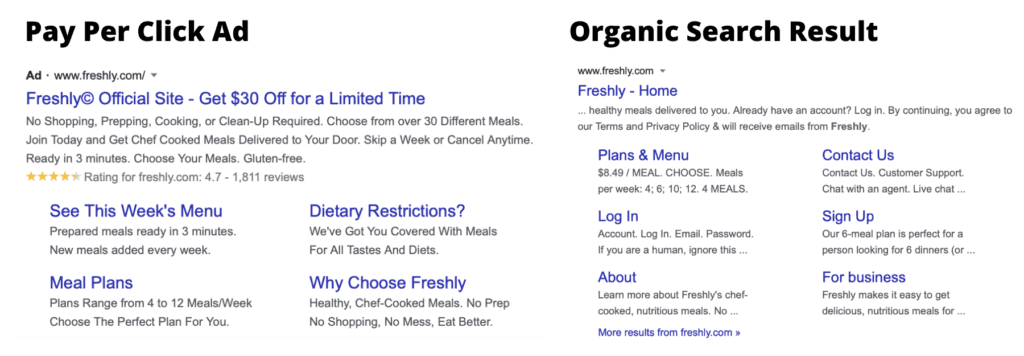
Pay-per-click ads essentially allow you to buy your way to the top of the page. But it’s not something you can just throw money at – a lot of stars need to align in order for an ad to get a top spot on its own, but there are services out there, called DSPs or demand side platforms, that can help you get there. DSPs help you…
- Research and select the right key words and organize those words into ad groups or campaigns
- Create relevant, useful content on your site or landing pages that drive conversions
- Bid on available advertising inventories in real time on your behalf
If you do a great job at all of the above, Google will reward you a top spot on the page and possibly even a lower cost per click.
Lastly, those coveted top spots are determined by a calculation of Ad Rank, a metric determined by a company’s “bid” on keywords (this is the highest amount they’re willing to spend on clicks for particular keywords) and their Quality Score (a combination of factors such as landing page quality, relevance of keywords, click-through rate, and ad quality). Using competitor keyword research tools such as SpyFu, we can see that the average cost per click for “meal delivery service” is quite high, but more descriptive, long-tail keywords like “vegetarian meal delivery service” would be a better choice based on cost per click and competitor activity.
SEO
Search Engine Optimization, commonly just called SEO, consists of optimizing content both on and off your website in order to place higher on search engine results pages.
Onsite SEO refers to strategies for improving content on your site so that it’s more useful and relevant to users and makes your site easier for search engines to crawl. Search engines use programs called Web Crawlers to visit sites all over the Internet, analyze each page’s copy and meta tags, and store (index) these pages to return as search results for relevant keywords. SEO involves creating valuable content with well-researched, long-tail keywords in order to answer popular questions. Consistent posting or timely (recent) posts tend to perform better than older posts. Alternatively, you can periodically update older content to keep it fresh and relevant.
Short Tail Keyword: Short tail keywords are broader, more general searches consisting of one to three words. Short tail keywords enjoy greater search volume, but as a result, tend to be more competitive when it comes to ranking.

Long Tail Keyword: Long tail keywords are more descriptive searches containing more than three words. Long tail keywords drive less traffic, but visitors to your site tend to be further along in their path to purchase than those using short tail keywords.

Optimizing HTML elements on your website can help improve your ranking and click through rates.
The title tag indicates the content of the web page and is the large heading for each result, typically what you would read first as you scan the results page. Meta descriptions are short paragraphs beneath the title tag that leverage relevant keywords to tell both the search engine and the user what is on the page. Sitelinks appear below the meta description and allow users to easily navigate to other pages on your website directly from the search engine results page. Sitelinks only appear below your search result if the search engine’s algorithm deems other pages on your site to be navigable and relevant.
Spend some time optimizing these elements using your site’s SEO plugin. These changes will make it easier for search engines and users to find your website and can have a significant impact on your results.
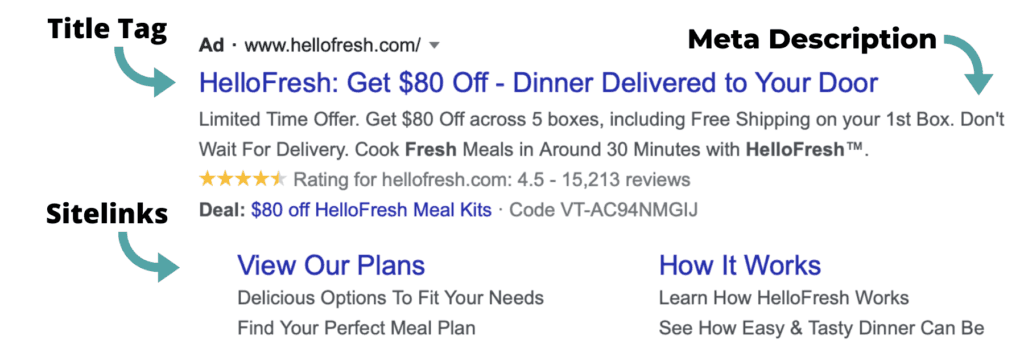
Offsite SEO consists of measures taken to improve search results via other websites and links. Backlinks to your site from authoritative sources help build your site’s credibility and reliability, and, in turn, your search results. This involves guest blogging on well-known sites in your industry or niche and creating content that readers want to share (which often indirectly contributes to backlinks to your website). As with anything, think quality over quantity. Relevant backlinks are important as Google penalizes sites that use links that are irrelevant to the page’s content. Penalties range from downgrading your ranking to removing your site from Google’s index altogether.
Websites
A fast, well-designed website that is optimized for mobile is table stakes for effective digital marketing. We’ve all experienced that pang of frustration when a site takes too long to load, page elements appear to jump around, or you can’t quickly find what you’re looking for. A study by Deloitte Digital and Google found that improving your website’s load time by just 0.1 seconds can boost conversion rates by 8%. Well-organized site navigation and quality landing pages also help to contribute to the overall user experience. You can check out Google’s Test My Site tool to see how your website is performing on desktop and mobile, and receive a comprehensive, customized report with suggested improvements that you or your developers can use to begin making changes.
The common theme in this corner of the digital marketing world is content. Quality content delivered via a satisfying user experience on your website and other credible websites will improve your ad ranking, your organic search results, and website conversions. We have just begun to scratch the surface of Digital Marketing! Join me in my next post where I’ll dive into paid and organic social media marketing and conversation marketing!
Need help designing or executing your digital marketing strategy? Incendio’s digital marketing team provides ad-hoc and full-service digital campaign and messaging support to assist you with marketing and advertising delivered across all digital channels – website, social media, mobile applications, email, web applications, search engines, websites, or any digital channel. Incendio does website design, digital design, pay per click, SEO, deployment and analysis. Reach Jenn at JennMcMillen@IncendioWorks.com





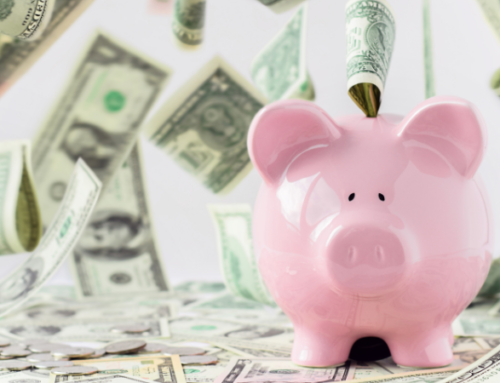
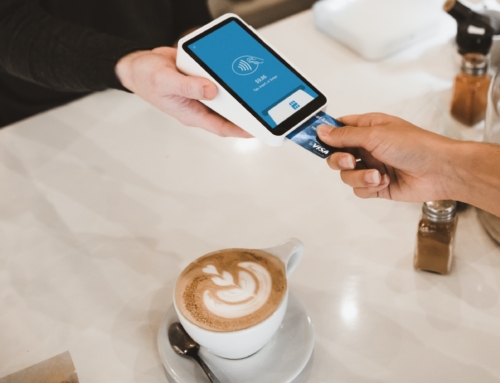

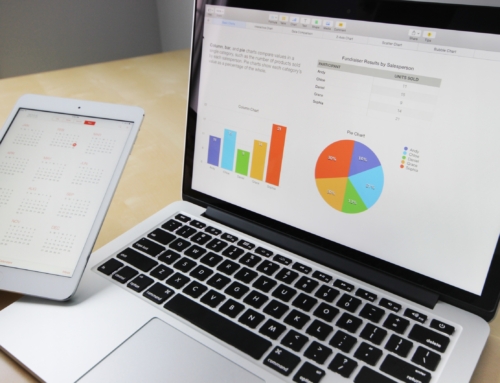

Leave A Comment